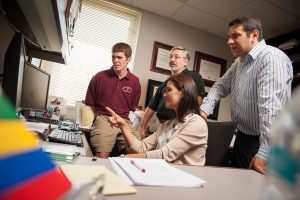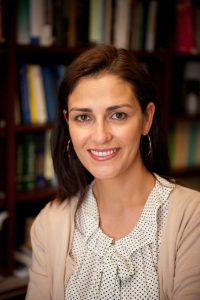By Edith Parten
Photos by Zach Riggins

A group of University of Alabama business researchers teamed with a heavy duty truck and trailer supplier to solve a product distribution challenge and achieve cost-savings for the company.
Drs. Chuck Sox and Burcu Keskin, business analytic experts in UA’s Culverhouse College of Commerce, along with two doctoral business students, Ibrahim Capar and Nickolas Freeman, used their talents to help Webb Wheel in Cullman keep the wheels turning and the trucks rolling.
The company manufactures aftermarket brake drums, hubs, spoke wheels and rotors for heavy-duty trucks and trailers. The problem facing the company: combining daily orders, separating the orders into truck loads, less-than truckloads and containers, then determining the best routes to get those orders to their customers in a timely, cost-efficient manner.
“Webb Wheel is always looking for ways to improve our products and processes,” says John Walker, vice president of operations.
With two plants – one in Alabama and one in Arkansas – Webb Wheel serves a customer base spanning nationwide with more than 4,600 ship-to locations. It doesn’t own a truck fleet, so it relies on contract carriers for product distribution.
Tracking daily orders and trying to determine the optimum times to ship full loads cost the company money and time. Webb Wheel knew there had to be a better way.
Looking beyond the literature
With no off-the shelf software available to assist, the company turned to UA’s Culverhouse College of Commerce to reduce costs and improve product distribution efficiency.
“Mike Krassick, our director of materials and logistics, has a son, Stephen, who is attending The University of Alabama,” says Walker. “He’s in the ISM (information systems, statistics and management science) program at Culverhouse working on a similar project, so we thought this could be a great project for UA.”
Krassick contacted the research professors who specialize in data analytics and supply chain optimization, and it became a project that merged the theory of academia with real world operations.
“The problem is unique in that nobody has ever developed a solution,” Sox says. “We could not find anything in previous academic literature relating to this issue.
“Companies usually outsource their shipping or the customer pays for the shipping,” Sox says. “It was important for Webb Wheel that they structure the shipping into their pricing, and it was important for them to try to analyze those costs.”

The solution produced by the faculty and student team was to develop an efficient loading and routing optimization model that links production output with shipment quantities to delivery locations via the optimal selected transportation mode. Then, they created a software program that includes a mapping feature that assists with optimizing routes and loads.
Off-the-shelf software and third-party logistics companies Webb previously interviewed looked only at orders and routed them without verifying inventory, says Krassick.
By shipping complete orders on time and creating routes for multiple drop loads, Webb knew it could reduce total load miles and freight costs while becoming more “green.”
“UA took all factors into consideration and developed algorithms and software to help with our freight ‘routing efficiency factor’ issue, which was the end goal,” Krassick says. “No one else could provide the answer. UA did.”
A humbling experience
Keskin says the issues facing Webb Wheel excited the Culverhouse team because the problem was complicated with all of the realistic challenges, uncertainty of future orders, inventory rules, drops and transportation and weight restrictions.
“There was no existing method or academic research addressing the problems,” Keskin says. “So, we had to come up with something totally new. We had to go back to the drawing board several times before we came up with a solution. It was a humbling experience.”

Just when the team thought it had a solution to optimizing Webb Wheels’ outbound supply chain, another roadblock appeared.
“The challenge of the project was the constant rollercoaster of figuring out every day what the new limitations were, what the new problems were and incorporating all of the real-world considerations into the model,” says Freeman, one of the UA doctoral students. “Determining how to do that was key.”
“We are still benefiting from this experience, and we get to contribute to the new academic literature,” says Capar, the other doctoral student involved. “That’s exciting. In the process, we learned a lot as a whole team.
“I think the biggest roadblock was to truly understand the problem because, coming from academia, we have a set of assumptions that we inherit from literature. We had all of those assumptions challenged at some point.”
A sense of accomplishment
Since implementing the load-planning and routing software, Webb Wheel has achieved cost savings. Company representatives say they foresee working with the University in the future to further develop and improve upon the software.
“I believe the highlight of the project was to actually be able to go in and see the real benefits experienced by a company,” Freeman says. “That is always something that gives you a sense of accomplishment.
“It’s not just about theory,” he says, “although we had to use that theory to make good business decisions. I think we’ve done that with this project.”
UA’s department of information systems, statistics and management science has collaborated with businesses and state agencies on multiple projects over the years, and Sox says he expects more opportunities.
“One of the main goals of the department is to have faculty and students working on real-world projects,” Sox says. “Solving real-life problems that oftentimes have additional complicated constraints or additional policy makes these problems challenging,” he says. “But, if we are really going to focus on being relevant and having an impact on business practice then we’ve got to roll our sleeves up and work on real problems facing businesses.”
Dr. Sox is a professor and head of the department of information systems, statistics and management science, and Dr. Keskin is an associate professor in the department.
